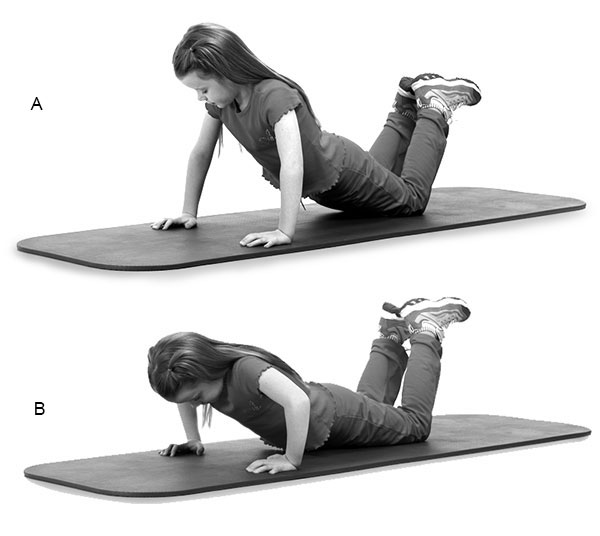The Truth about Waist Training
It starts with the Kardashians and Jenners, the Borg Collective of unmerited fame. The ovary-bearing members of the clan currently promote “waist training,” which involves, I shit you not, wearing a corset all day with the goal of making your waist smaller.
When Kylie Jenner recently posted a picture of herself wearing one on Instagram (see below), it got 1.4 million likes and more than 30,000 comments within a day.
But it’s not just Kardashians. There’s also a Real Housewife (who claims to have lost four inches from her waist), the singer Nicki Minaj, models whose names I’m too old to recognize, and Lindsay Lohan, because of course Lindsay Lohan.
Related: The Anarchy Workout—one guy lost 18 pounds of pure fat in just 6 weeks!
The idea, at first, just seemed crazy to me. We know there’s no such thing as spot reducing. Your body gains and loses fat systemically. Even if it were possible to micro-manage the process, there’s no reason to think that squeezing one section of your anatomy will reduce its size.
But the more I read, and the more stories I saw from people who loved or hated them, the more I wondered if there might be a body-changing mechanism I hadn’t considered. Then I learned that at least one company, Hourglass Angel, also makes waist-cinching products for men. I decided to take a closer look.
Some Restrictions Apply
Corsets have gone in and out of fashion for hundreds of years. Interestingly, their popularity in England coincided with the mass importation of sugar in the 17th century, according to Calories and Corsets: a History of Dieting Over 2,000 Years, by Louise Foxcroft. It wouldn’t be the last time fashion would square off against food.
The current corset revival seems to have begun in Colombia, where, according to this article in The Fader, the shape-shifting undies became a hit among new moms eager to get their pre-pregnancy bodies back.
The other reason for their appeal, which has been true throughout history, is the desire for an almost impossibly curvy figure, with a tiny isthmus of a waist between double-handful boobs and Indian burial mound buttocks.
A tiny percentage of human females can achieve that shape naturally, before fast food, childbirth, and gravity do their work. Some can fake it with the fitness-babe trifecta: silicon up top, heavy deadlifts down below, and washboard abs in between.
But that requires more time, effort, and self discipline than most women are willing or able to put out. And even when they do, there’s no guarantee it will work.
Related: 6 Insanely Fit Guys Reveal One Thing They Do Each Day
That’s when some women turn to the corset. Or, as it’s currently branded, the “waist trainer.”
What, exactly, does it train? It obviously compresses the waist, but there’s no reason to think the effect would be permanent. As soon as you take it off, the real you bounces right back into place.
Some companies refer to a process they call “fat cell mobilization.” Because the corsets are meant to be worn all day, even while exercising, the fat around the waist will get tired of being squeezed and find another place to hang out. Or so they want their customers to believe.
Hourglass Angel is a bit cagier with its claims. It says its products increase sweat rate, but stops short of making the obviously bogus claim that sweat equals fat loss. Instead, the company recommends “pairing a waist-training regimen with a healthy lifestyle that includes nutritious eating habits and exercise.”
But it adds this: “While you’re wearing your waist trainer, you might find yourself eating less because your stomach is restricted.”
Related: Exposed: “Fitness Pictures” Are Fake!
First-person reports by skeptical corset-testers indeed confirm appetite loss as one of the first things that happens. “It’s like wearing a pair of tight pants while having a big dinner,” says Chad Waterbury, MS, a personal trainer in Los Angeles and author of Huge in a Hurry. “It traps gas and makes you feel pretty crappy.”
Chronic abdominal distress could indeed reduce your overall intake, Waterbury says, but with a catch. “It can cause a person to deposit more fat in the problem areas.”
But there’s an even bigger worry for corset wearers.
Bad Breath
By the time I talked to Waterbury I had already sent for the Core1 Compression Band, Hourglass Angel’s male corset. Made of 75 percent rubber and 25 percent cotton, and weighing just 9 ounces, the beige-colored Core1 looked more like your grandmother’s varicose vein stockings than a Victorian undergarment.
It didn’t take long to decide which of the two columns of hook-and-eye fasteners I should use. I could barely reach the innermost loops with the innermost hooks. It fit snugly from the lower ribs to the upper pelvis.
The first thing I noticed: It was harder to breathe. I couldn’t imagine wearing the Core1 to my workout that afternoon. That’s also what worries Waterbury most.
“I think the idea of wearing a corset while working out is pretty dumb,” he says. There’s no benefit, and there’s a significant drawback: impaired function of the diaphragm, “the only skeletal muscle you can’t live an active life without.”
Skeletal muscles are the ones that connect to bones to create movement, like your biceps and hamstrings. The diaphragm, which connects to ribs and vertebrae, makes those movements possible. It contracts as you draw breath into your lungs, providing your muscle cells with oxygen.
Squeezing the diaphragm also restricts its blood flow, which means it gets less oxygen than it ordinarily would.
Related: How to Breathe for Better Performance and Better Health
“Nothing good comes from making a muscle hypoxic for hours each day,” Waterbury adds. “You’d experience diminished strength and neural activation,” since nerves, like muscles, require sufficient oxygen to function at peak efficiency.
The Fat Signal
All that said, if your only goal is to have a smaller waist, Waterbury thinks there’s a hypothetical chance it could work over a long period of time—years, rather than weeks or months. That’s because your waist expands over your lifetime.
“The likelihood of offsetting the natural gut expansion is probably pretty good,” he says. “The body won’t grow tissue if there’s no room.”
As an example, he mentions Dita Von Teese. She’s a model and burlesque dancer who claims to have permanently reduced her waist to a wasp-like 22 inches by “tightlacing” her corset, sometimes squeezing her stomach to as little as 16 inches. (For reference, that’s three-fourths of one of J.J. Watt’s arms.)
Which brings me to the second thing I noticed when I spent a morning in a belly binder. I was immediately, intensely, and constantly aware of my gut. One of the benefits of working from home is that I never have to wear tight or uncomfortable clothes. Which is also a huge drawback.
Related: The 25 Best Ab Exercises
I could pretend the four pounds I’d gained this year was mostly muscle, until a corset squeezed all the fat into one squishy space and made it impossible to ignore.
Now I understand why so many corset-wearing celebrities and their fans believe “waist training” is actually a thing. As Waterbury said, it might be, if you wear a genuinely restrictive device hours a day for years on end.
But in the short term, the biggest change is most likely awareness. Corralling your flab the way I did sends a distress signal to your brain, one that says, “Don’t feed me!”
-
Abs Diet: Healthy Snacks or Trans Fat
Partially hydrogenated oils are everywhere. You cant eliminate them fr
-
4 Easy Lunch Ideas to Lose Weight
I remember walking into the lunch room one day in the fall of 8th gra
-
The Worlds Most Powerful Eating Strategies
Every nation has its weapons in the nutrition wars. For the Chinese, i
-
Weight Loss: The Ultimate Confidence Booster at
Vitals: Brian Brink, 27, Lakeland, FL Occupation: Salesman Height: 60
-
Is This Sugar Making You Fat?
You’ve heard the claims that sugar is detrimental to your diet, but is
-
Athlete Weight-Loss Plan:
Most professional athletes are blessed with great genetics—and then th
- DON'T MISS
- Are cardio or weights better?
- 3 Moves to a Slimmer Middle
- 35 Strategies to Make You a Better Man
- Women Weight Loss Partners
- Abs Diet: Stress and Comfort Foods
- Abs Diet: Muscle Building Tips
- The Simplest Workout Motivation Trick Ever!
- The Best Time to Write Your Grocery List
- Diet Strategies: Exercise and Weight Loss
- Weight Loss: Abs Diet Foods and Metabolism




